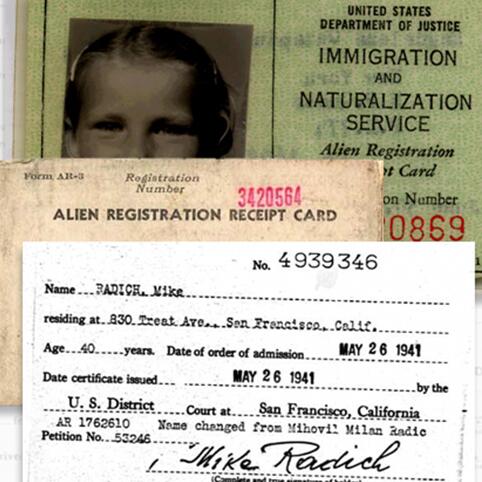AR2 Form Image Gallery
The 1940 Alien Registration Act required all aliens age 14 and older to be registered and fingerprinted. From August to December 1940 more than five million alien residents of the US registered at Post Offices while agency employees processed the millions of 2-page registration forms. The form used was the AR-2, Alien Registration Form.
The images shown in this gallery reflect typical information found in AR2 Forms and are for representative purposes only. Some data have been omitted due to privacy reasons. Documents availability vary by case.
The first question on the AR-2 form asked about the immigrant’s name: What is their name, what name did they use at the time of entry, and what other names did they use? Up to three names were cross-indexed to their Alien Registration Number in the INS (now USCIS) indices. The form also called for a present address (question 2), exact date of birth (question 3a) and exact place of birth (question 3b). Variant names all linked to one street address and date and place of birth made the A-Number a unique identifier.
Question 7 asked for the port, date, and ship of the alien’s last (most recent) arrival and their status at that time (passenger, crew, stowaway, etc.). Question 7e asked for the date of the first arrival, which may or may not be the same as the last. AR-2 forms can be very valuable when researching
immigrants who were elderly aliens in 1940. In the example above, the immigrant knew he came through New York at about two years of age, but had no more specific information. Nevertheless his answer could help to narrow or focus a search that previously had no clue to follow.
AR-2 Forms can be especially helpful in cases where no other arrival record exists. In this example the immigrant came from Mexico to Texas as an infant in 1855, a half-century before the US Government first created immigration records at the Southern Border. Though the arrival information came from memory and was not verified, if the immigrant did not naturalize the AR-2 Form may be the only record where the immigrant claimed a port and date of arrival.
The Great Depression shifted many people out of their regular jobs, so question 9 asked registrants about their usual occupation as well as their present occupation. It also called for the name, address, and “business” of
their employer. A wide range of occupations are represented in the AR-2 Form records.
Question 10 asked about membership in clubs, organizations, or societies over the prior five years. Some registrants listed every membership they could imagine, from religious to political to social. Others left that question blank.
Question 11 called for information about prior military service, specifically the country, branch of service, and dates, and could point to additional records in the old country.
Question 12 asked the registrant whether they ever filed “first papers” for naturalization, and if so when and in what court. It called for the same if a petition for naturalization had been filed. This information could lead a researcher to a previously unknown court naturalization record or a later USCIS file.
Question 14 called for criminal record information, and can sometimes provide surprising clues to additional police or court records.
Each registered alien had to sign the AR-2 form. If illiterate, they entered “their mark” and a friend or witness signed for them. An alien registration official also signed the form. The official was usually a US Postal Service employee who stamped the form with the registration date and place.
USCIS Genealogy Program Record Requests for AR-2 Forms must include the A-Number. Researchers may find A-Numbers on index cards to court naturalization records after 1941, on original alien registration receipt cards, or other of the immigrant’s personal papers. If the immigrant registered as an alien in 1940 their A-Number can be learned from an Index Search request.

